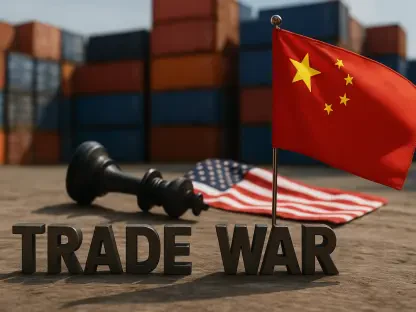In 2025, the world grapples with the ramifications of renewed sanctions on Iran, a significant player in the global oil market. These sanctions, primarily led by the United States and aligned nations, aim to curtail Iran’s nuclear ambitions and address its destabilizing actions in the Middle East. However, the repercussions of these sanctions are deeply intertwined with global energy dynamics and economic strategies. As a result, investors and policymakers are navigating a complex landscape where geopolitical decisions are starkly influencing energy supplies and global market stability.
Geopolitical Implications of Rising Tensions
Iran’s Resilience and Global Energy Supplies
The resurgence of sanctions against Iran presents a nuanced challenge, as Iran’s oil sector remains a critical artery for its economy. With exports averaging 3.22 million barrels per day, Iran has worked diligently to maintain robust ties with major energy consumers, notably China. Despite the overarching restrictions imposed by U.S. sanctions, China continues to serve as Iran’s largest oil purchaser, sidestepping U.S. financial ecosystems to ensure consistent trade flows. This relationship illustrates not only Iran’s adaptability but also the potential for these sanctions to lead to heightened tensions between Western powers and China’s growing influence in global energy markets.
The renewed sanctions, particularly reinforcements from the JCPOA, are poised to exacerbate the already delicate energy supply balance. Should international agencies like the IAEA flag Iranian non-compliance, potential reinstatement of UN sanctions could dramatically shrink Iran’s oil output. This reduction is estimated at anywhere between 150,000 to 400,000 barrels per day, potentially sending shockwaves across the markets. Such cuts may create a tighter supply environment, pushing oil prices upward towards the $100 mark, particularly under unfavorable market conditions. Consequently, countries dependent on stable energy prices face the daunting task of mitigating these increases, which could have far-reaching impacts on economic stability at a global level.
Strategic Partnerships and Dynamic Economies
A transformative element of the current sanctions landscape is the burgeoning strategic collaborations between Russia and Iran. Formalized through a treaty in mid-2025, this partnership seeks to circumvent Western sanctions by capitalizing on alternative trade arrangements and financial mechanisms like the MIR payment system. By avoiding U.S. dollars in their transactions, these nations not only strengthen each other’s economies but also contribute to the ongoing de-dollarization of the global energy market. This shift provides an intriguing prospect for investors focusing on non-dollar denominated assets to capitalize on emerging market dynamics.
However, this alliance also introduces potential vulnerabilities, particularly as Iran and Russia deepen cooperation in critical sectors such as energy and nuclear technology. The specter of military conflicts, especially involving strategic sites like Iran’s burgeoning nuclear infrastructure, adds a layer of unpredictability. Should tensions escalate to military interventions by nations such as the U.S. or Israel, it could trigger significant disruptions, ranging from physical destruction to large-scale radiological emergencies, with ramifications reaching far into international markets.
Strategic Investor Responses
Adaptation in Asset Allocation Strategies
The multifaceted challenges posed by the sanctions necessitate sophisticated investment strategies that account for the current volatility. Investors are urged to incorporate a broad spectrum of defensive and alternative assets to protect against potential market disruptions. Historical analyses of past geopolitical events underscore the importance of incorporating uncorrelated assets into investment portfolios. Precious metals such as gold continue to be perceived as reliable safe-havens that maintain value during fluctuating energy crises, offering a stabilizing effect against currency devaluation and inflationary tendencies triggered by geopolitical unrest.
Incorporating a blend of traditional and innovative assets, such as digital currencies, further diversifies risk exposure. These digital assets stand to gain from a de-dollarizing economy, offering attractive alternatives as many nations decouple economic transactions from U.S. currency dominance. Moreover, strategic investment in defensive sectors such as infrastructure and geopolitical insurance instruments provide additional safeguards. By hedging predicted risks, portfolios can achieve resilience against unforeseen market upheavals, ensuring both stability and growth potential in an otherwise unpredictable investment climate.
Navigating Infrastructure and Energy Dynamics
Infrastructure investments, specifically in projects such as the International North-South Transport Corridor, require careful deliberation amid the geopolitical shifts induced by sanctions. Stretching across crucial trade routes linking Russia, Iran, and India, this initiative epitomizes high growth potential tempered by substantial geopolitical risks. Nonetheless, opportunities within this corridor, including nuclear and logistics projects, demand astute risk management through geopolitical insurance and diversified revenue strategies. By securing insurance against political risks, investors can develop a comprehensive coverage network to protect investments from potential conflicts or sanctions-induced disruptions.
Furthermore, keeping abreast of emerging energy partnerships like those between Iran and Russia offers advantageous entry points into non-traditional energy markets. Ensuring portfolio balance with exposure to stable instruments such as U.S. Treasuries and commodities like gold mitigates regional instability’s effects. This prudent approach encourages adaptive portfolio management practices, including regular rebalancing aligned with economic trends.
Charting a Course Forward
In the year 2025, the global stage is witnessing the significant fallout from the re-imposition of sanctions on Iran, known for being a crucial component in the international oil sector. The United States, along with its allies, spearheaded these sanctions, driven by the objective to impede Iran’s nuclear program and mitigate its destabilizing actions in the Middle East, although these measures have far-reaching implications beyond the political realm. These sanctions are deeply connected to global energy dynamics, creating ripples that are felt throughout economic strategies worldwide. The sanctions are not just about curbing Iran’s ambitions; they are reshaping energy supplies and affecting global market equilibrium. Investors and policymakers find themselves in a precarious position, forced to wade through an intricate landscape where political maneuvers and decisions have direct and profound impacts on the availability and stability of energy resources, thus influencing global economic stability and trade relationships.









